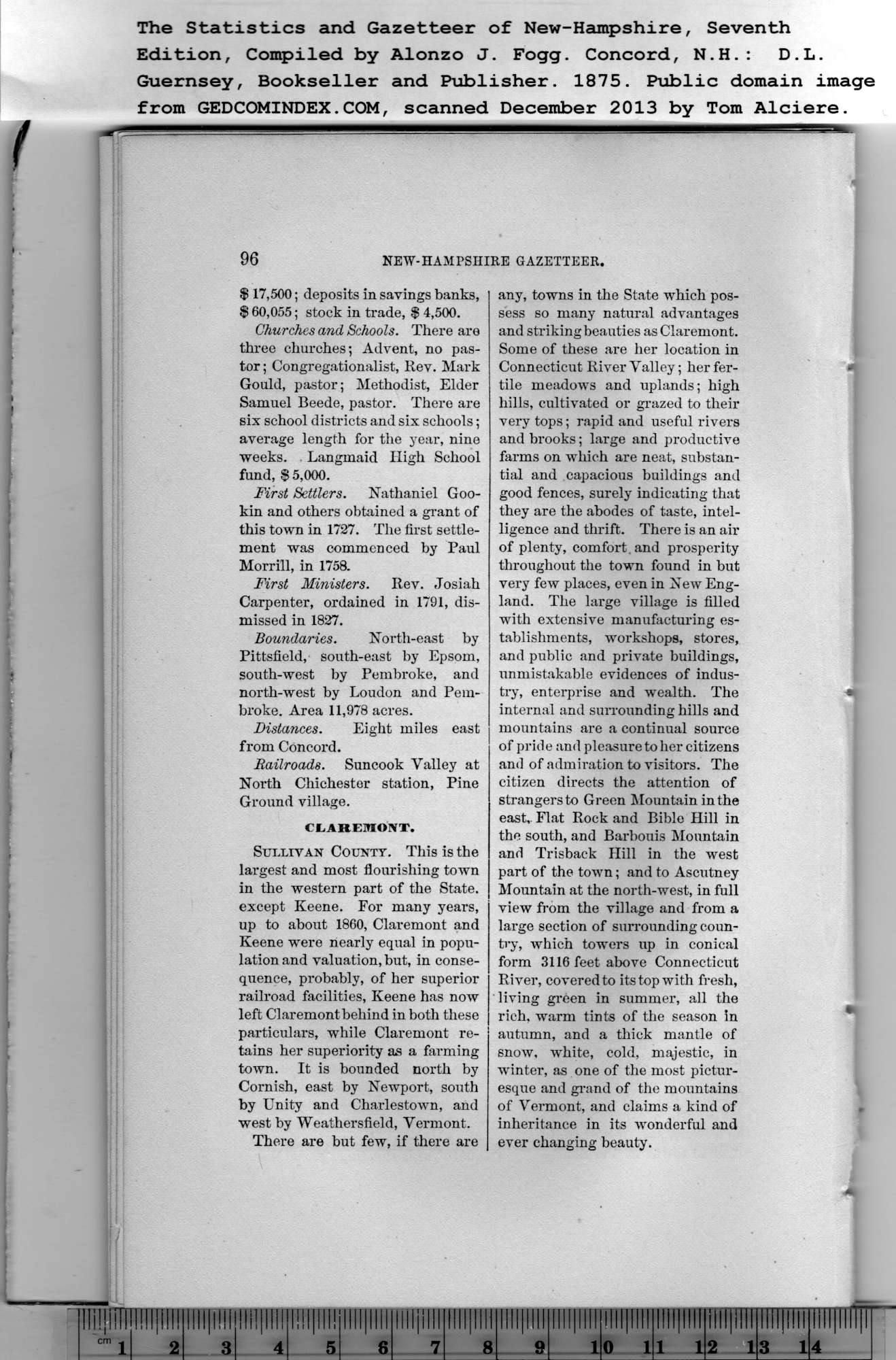|
96
The Statistics and Gazetteer of New-Hampshire, Seventh
Edition, Compiled by Alonzo J. Fogg. Concord, N.H.: D.L.
$ 17,500; deposits in savings banks,
$ 60,055; stock in trade, $ 4,500.
Churches and Schools. There are
three churches; Advent, no pas-
tor; Congregationalist, Rev. Mark
Gould, pastor; Methodist, Elder
Samuel Beede, pastor. There are
six school districts and six schools;
average length for the year, nine
weeks. Langmaid High School
fund, $5,000.
First Settlers. Nathaniel Goo-
kin and others obtained a grant of
this town in 1727. The first settle-
ment was commenced by Paul
Morrill, in 1758.
First Ministers. Rev. Josiah
Carpenter, ordained in 1791, dis-
missed in 1827.
Boundaries. North-east by
Pittsfield, south-east by Epsom,
south-west by Pembroke, and
north-west by Loudon and Pem-
broke. Area 11,978 acres.
Distances. Eight miles east
from Concord.
Railroads. Suncook Valley at
North Chichester station, Pine
Ground village.
CLAREMOIVT.
Sullivan County. This is the
largest and most flourishing town
in the western part of the State,
except Keene. For many years,
up to about 1860, Claremont and
Keene were nearly equal in popu-
lation and valuation, but, in conse-
quence, probably, of her superior
railroad facilities, Keene has now
left Claremont behind in both these
particulars, while Claremont re-
tains her superiority as a farming
town. It is bounded north by
Cornish, east by Newport, south
by Unity and Charlestown, and
west by Weathersfield, Vermont. |
There are but few, if there are
any, towns in the State which pos-
sess so many natural advantages
and striking beauties as Claremont.
Some of these are her location in
Connecticut River Valley; her fer-
tile meadows and uplands; high
hills, cultivated or grazed to their
very tops; rapid and useful rivers
and brooks; large and productive
farms on which are neat, substan-
tial and capacious buildings and
good fences, surely indicating that
they are the abodes of taste, intel-
ligence and thrift. There is an air
of plenty, comfort , and prosperity
throughout the town found in but
very few places, even in New Eng-
land. The large village is filled
with extensive manufacturing es-
tablishments, workshops, stores,
and public and pifivate buildings,
unmistakable evidences of indus-
try, enterprise and wealth. The
internal and surrounding hills and
mountains are a continual source
of pride and pleasure to her citizens
and of admiration to visitors. The
citizen directs the attention of
strangers to Green Mountain in the
east,. Flat Rock and Bible Hill in
the south, and Barbouis Mountain
and Trisback Hill in the west
part of the town; and to Ascutney
Mountain at the north-west, in full
view from the village and from a
large section of surrounding coun-
try, which towers up in conical
form 3116 feet above Connecticut
River, covered to its top with fresh,
living green in summer, all the
rich, warm tints of the season in
autumn, and a thick mantle of
snow, white, cold, majestic, in
winter, as one of the most pictur-
esque and grand of the mountains
of Vermont, and claims a kind of
inheritance in its wonderful and
ever changing beauty. |
